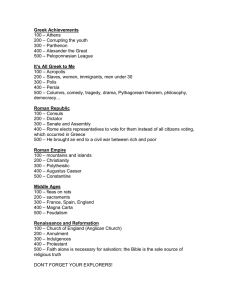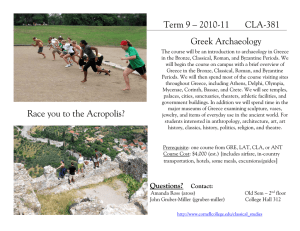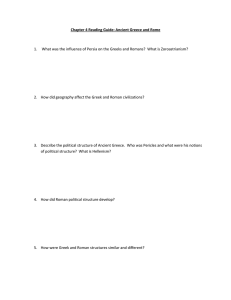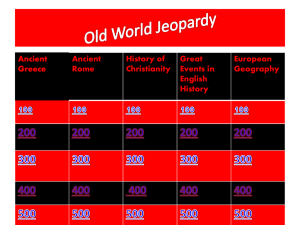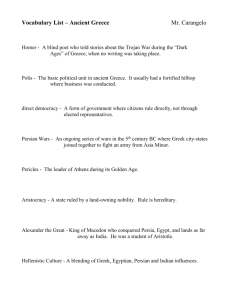AREAS OF INQUIRY IDENTITY, INSTITUTIONS, AND SOCIETIES
advertisement
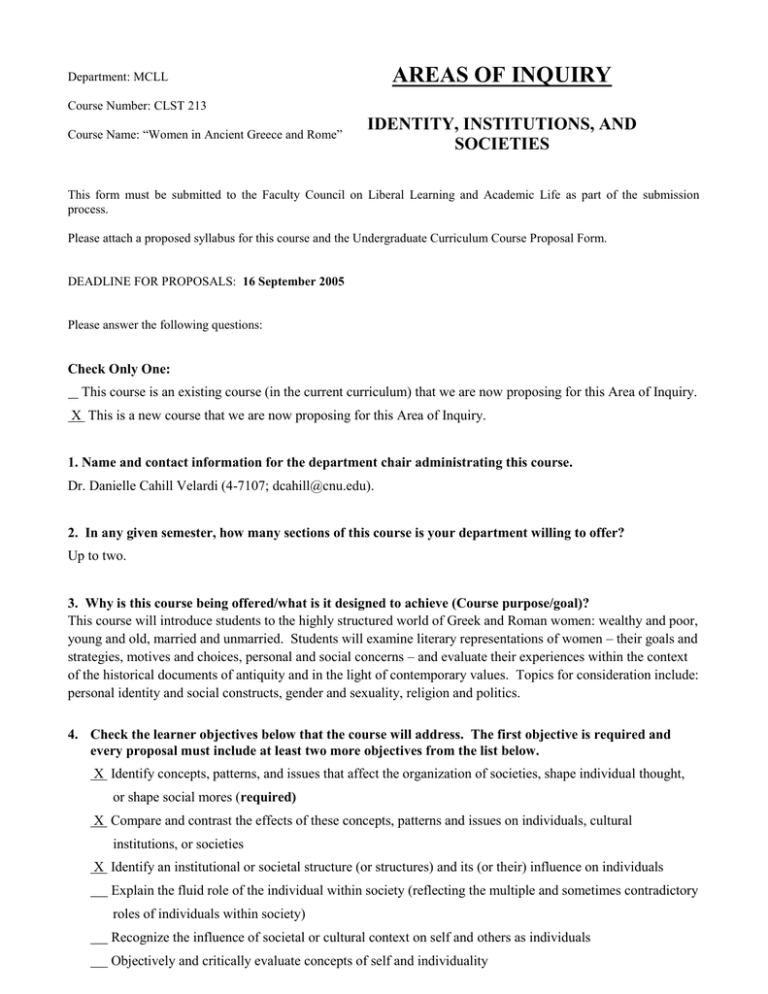
AREAS OF INQUIRY Department: MCLL Course Number: CLST 213 Course Name: “Women in Ancient Greece and Rome” IDENTITY, INSTITUTIONS, AND SOCIETIES This form must be submitted to the Faculty Council on Liberal Learning and Academic Life as part of the submission process. Please attach a proposed syllabus for this course and the Undergraduate Curriculum Course Proposal Form. DEADLINE FOR PROPOSALS: 16 September 2005 Please answer the following questions: Check Only One: This course is an existing course (in the current curriculum) that we are now proposing for this Area of Inquiry. X This is a new course that we are now proposing for this Area of Inquiry. 1. Name and contact information for the department chair administrating this course. Dr. Danielle Cahill Velardi (4-7107; dcahill@cnu.edu). 2. In any given semester, how many sections of this course is your department willing to offer? Up to two. 3. Why is this course being offered/what is it designed to achieve (Course purpose/goal)? This course will introduce students to the highly structured world of Greek and Roman women: wealthy and poor, young and old, married and unmarried. Students will examine literary representations of women – their goals and strategies, motives and choices, personal and social concerns – and evaluate their experiences within the context of the historical documents of antiquity and in the light of contemporary values. Topics for consideration include: personal identity and social constructs, gender and sexuality, religion and politics. 4. Check the learner objectives below that the course will address. The first objective is required and every proposal must include at least two more objectives from the list below. X Identify concepts, patterns, and issues that affect the organization of societies, shape individual thought, or shape social mores (required) X Compare and contrast the effects of these concepts, patterns and issues on individuals, cultural institutions, or societies X Identify an institutional or societal structure (or structures) and its (or their) influence on individuals Explain the fluid role of the individual within society (reflecting the multiple and sometimes contradictory roles of individuals within society) Recognize the influence of societal or cultural context on self and others as individuals Objectively and critically evaluate concepts of self and individuality 5. Briefly explain how this class addresses the above objectives. A course may cover more than three objectives. a. Identify concepts, patterns, and issues that affect the organization of societies, shape individual thought, or shape social mores. The readings for this course are designed to illuminate the experience of women in ancient Greek and Roman societies, as well as the institutions, traditions, and beliefs that shaped those experiences. Students will study the position of women reflected in Greek and Roman literature, laws, and political and social institutions in order to appreciate the remarkable impact that gender differences – real and imagined – had on the organization of Greek and Roman societies. Because history has preserved so few texts written by women in antiquity (Sappho being the major exception), one of the central tasks of this course will be to distinguish the concept “woman” from historical “woman” – an issue complicated further by virtue of the fact that male-authored literary representations of women consistently seek to justify and reinforce the highly structured nature of classical societies, in general, and narrowly circumscribed roles for women, in particular. Careful examination of the Greco-Roman literary tradition reveals that the roots of the unequal status of men and women in classical Greece and Rome can be seen as far back as the 8th century B.C. poet, Hesiod, who in the Theogony and Works and Days suggests that a woman’s reproductive power must be controlled and subjugated by men, and accordingly it is Pandora, the first woman, who is responsible for unleashing previously unknown evils into the world of men. This “natural” dominance of men over women is underscored throughout classical literature, mythology, and religion, and institutionalized in law codes, constitutions, and even the concept of citizenship, which excluded women. b. Compare and contrast the effects of these concepts, patterns and issues on individuals, cultural institutions, or societies. Gender issues shaped the lives of individuals, as well as institutions and society at large in both Greece and Rome. In certain areas of life, there are enough similarities between the experiences of Greek and Roman women across historical periods to make a few generalizations. For example, many of the protections/restrictions on women that kept them out of most public arenas and confined them to their father or husband’s home were enacted to protect the legitimacy of heirs: money, property, possessions, and religious offices were all passed down from father to son, and the introduction of bastard offspring could cost a family everything; as a result, women were often betrothed at or before puberty. Ancient women also lacked political rights: they could not attend, speak at, or vote in political assemblies, nor could they hold office; because they were thought to be easily manipulated, women were supposed to have a guardian, such as a father or husband or, in their absence, a kurios (Greece) or tutor (Rome). Naturally, it would be misleading to speak about women’s experiences in Greece or Rome as if they were monolithic, as there were significant differences: in particular, Roman society afforded women more opportunities and freedoms than their Greek counterparts. For example, archaeological evidence suggests that women in classical Athens were typically confined to the “women’s quarters” when at home, whereas no such gendered space existed within a Roman house. Furthermore, the decline in power of the Roman senate and assemblies in the first century B.C. coincided with the rise in power of the imperial family, which resulted in increased influence for its women; after the reign of Augustus, free-born women who had given birth to three (or more) children were not required to have a guardian in the absence of a father or husband, a widow was allowed to take over her husband’s business, and in the later imperial period male guardianship of Roman women seems to have become a mere formality. c. Identify an institutional or societal structure (or structures) and its (or their) influence on individuals. The institutions, traditions, and beliefs of Greece and Rome collectively created a patriarchal societal structure that rigorously excluded women from participating in the public arena – even though women had no voice in creating or shaping public policies, they were nevertheless subject to those policies. This exclusion from public life created few opportunities for women outside of the home apart from obvious “female” roles as midwives or wet nurses, and so most women took control in the management (nomos) of the home (oikos) – hence our term “economics” – a role of vital importance for the stability and continuity of ancient societies. Despite the significance of managing a household, women were invariably praised only for silence and invisibility. For example, in Classical Greece a woman’s name was not spoken publicly unless she was dead or of ill repute; glory for a woman was defined by Pericles in the Histories of Thucydides as, “not to be spoken of, whether in praise or blame” (2.45). 6. Course Assessment: Identify how this course will accomplish the above objectives (choose at least one). X Participating in class discussion and debate Engaging in teamwork and other collaborative exercises X Writing analytical or evaluative papers, perhaps incorporating original research Making oral presentations Creating an artistic product or a performance Participating in fieldwork X Other means: quizzes on factual matter; essay exams; final comprehensive essay. 7. Attach a proposed syllabus, which includes a statement of purpose, course objectives, and how these objectives will be accomplished. Please see attached. 8. If this course contributes to any of the foundations for liberal learning given below, please explain how. <X> Oral Communication Literacy: Along with each reading assignment (ancient and modern) I will supply the students with a series of “Discussion Questions” designed to focus attention on significant ideas/concepts and to help students prepare for class discussions; I will supply the necessary background information for each topic, but students will then be expected to explore said topic through class discussions (with guidance from the instructor, as necessary). <> Information Literacy: <X> Writing Literacy: Students are required to write five brief (i.e., no more than two-page) response papers on topics related to reading materials, which will help students prepare for class discussion, develop intellectual independence, and practice literary and critical analysis on ancient and modern texts. Students will also be required to take in-class essay exams, including a comprehensive final essay exam – all of which will require students to evaluate and synthesize material from a broad range of topics. 9. Explain how this course connects to Vision 2010 – the CNU Strategic Plan (www.cnu.edu/Vision2010). “Our academic programs will create independent learners prepared intellectually and practically to understand the world” (Vision 2010): in order for students to be “prepared intellectually and practically to understand the world” it is essential that they understand the traditions, institutions, and ideas that have shaped – and continue to shape – the world; this course is designed to illuminate the experiences of women in Greek and Roman societies, as well as the attitudes and societal structures/institutions that shaped those experiences. It is expected that once students understand the historical roots of patriarchy and misogyny they will have a deeper understanding of these issues in contemporary society and a greater capacity for effecting changes based on sound reasoning and historical perspective. Furthermore, because this course will require students to analyze ancient texts (both prose and poetry) pertaining to women, students will be exposed to analytical tools from disciplines such as Classical Studies, English, History, Philosophy, and Gender Studies in accordance with the goal to “cultivate analytical and integrative thinking within and across the disciplines” (Vision 2010). Submission Checklist: By the deadline, submit a packet with the following documents to the Assistant Dean for Liberal Learning. Please submit in electronic and hard copy form. __X__ Area of Inquiry Course Proposal Form __X__ Syllabus for the Course If needed: __X__ Undergraduate Curriculum Committee New Course Proposal Form _____ Undergraduate Curriculum Committee Change to Existing Course Form Women in Ancient Greece and Rome Course Description Classical Greek and Roman societies were highly structured, especially for women. In Greece – Athens, in particular – women led very private lives and were rarely even seen by men (except for immediate family); in Rome, women had fewer restrictions, but were still largely under the control of their fathers or husbands. Although Greece and Rome were carefully structured, patriarchal societies where women were severely protected/restricted by laws and customs, women nevertheless played important roles and feature prominently in both literary works and historical documents. In literature, women are not simply lauded for their fidelity (Penelope), determination (Antigone), and sense of honor (Lucretia), but also feared for their cleverness (Medea), vindictiveness (Clytemnestra), and passion (Dido). Naturally, literary representations of women do not necessarily represent everyday experiences, although they do reflect underlying attitudes towards and assumptions about women. This course will introduce students to the experiences of ancient Greek and Roman women: wealthy and poor, young and old, slave and free, married and unmarried. Students will examine literary representations of women – their goals and strategies, motives and choices, personal and social concerns – and evaluate their stories within the context of the historical documents of antiquity and in the light of contemporary values. Topics for consideration include: personal identity and social constructs, gender and sexuality, religion and politics. Learning Goals By the end of the course, I want you 1. to identify the concepts, patterns, and issues that shaped the historical status and daily experiences of women in antiquity. 2. to compare and contrast the effects of these concepts, patterns, and issues on women in antiquity. 3. to identify the institutions that reinforced the patriarchal structure of ancient Greek and Roman societies and how they influenced the lives of women. 4. to be familiar with depictions of women in literature (by male and female authors) and how these depictions reflect historical attitudes towards women. Required Texts E. Cantarella, Pandora's Daughters: The Role and Status of Women in Greek & Roman Antiquity (Baltimore 1987) M. Lefkowitz & M. Fant, Women's Life in Greece & Rome: A Sourcebook in Translation (Baltimore 1992) S. Pomeroy, Goddesses, Whores, Wives, & Slaves: Women in Classical Antiquity (New York 1975) Reserve Texts M. Boatwright., The Romans: From Village to Empire (Oxford 2004) S. Pomeroy, Ancient Greece: A Political, Social, and Cultural History (Oxford 1999) Grading Policy Homework/Participation (100 points) 5 Response Papers (20 points each = 100 points) 2 Quizzes (50 points each = 100 points) 2 Exams (150 points each = 300 points) Final Exam (400 points) Your final grade will be based on a 1000-point scale: A = 930-1000 points, A- = 900-929, B+ = 870-899, B = 830-869, B- = 800-829, C+ = 770-799, C = 730-769, C- = 700-729, D+ = 670-699, D = 630-669, D- = 600-629, and F = below 600. Homework/Participation Participation is an integral component of the course, as all readings will be discussed and all homework assignments will be reviewed and corrected in class. You will be expected not only to come to class prepared, but also to contribute on a regular basis. Attendance is, of course, mandatory; especially since the exams – while based on the assigned readings – will emphasize material raised in lectures and class discussions. Response Papers Throughout the semester, you are required to write five short, informal papers (no more than two pages each) on the readings for class. You may choose which days and to which readings you want to respond, as long as you have completed five response papers by the end of the semester (with at least two papers each on Greek and Roman topics). I will provide a list of questions to go along with each day’s reading assignment for you to consider as the basis of your response. Response papers will be graded Pass/Fail. I want you to type them (so they are easier for me to read), but they need not be a perfect, polished product. Rather, response papers should be just what their name suggests – a response. Do not worry about answering every question I ask for each assignment. Instead, focus on the one or two questions that seem most interesting to you and be as specific as you can, getting down as much as you can, as quickly as you can. Treat these papers more like a journal entry than a formal paper. Normally, as long as you submit a response paper of suitable length, detail, and thoughtfulness (and turn it in on time in class on the assigned day), you will receive all twenty points the paper is worth. The purpose of the response papers is: 1. to help you in your preparation for class discussion. 2. to help me see if you are struggling with the readings. 3. to help you develop your intellectual independence and confidence as a reader of ancient source materials and modern criticism. 4. to practice literary and critical analysis on ancient texts. You may submit more than five response papers during the semester (to make up for any papers that do not receive a grade of “Pass”), but no matter how many you turn in, you will not receive more than 100 points total for all the papers you write. You may not submit more than one response paper on a single day, nor may you submit one for a day that you are absent from class – no exceptions. Even if you do not submit a response paper on a particular day, you should still come to class prepared to discuss the assigned questions for that day, since we will focus on those questions in our discussion of the reading assignment. Quizzes (nb: texts and notes may not be used) Quizzes will consist primarily of identification and short answer questions; their purpose is not so much to treat the course’s broader themes, as it is to ensure that students are familiar with important names, dates, and concepts, as well as essential background material. Exams (nb: texts and notes may not be used) The Exams will require you to demonstrate a familiarity with the factual content of historical works (names, dates, events) and the literary content of poetic works (major characters, themes, concepts). You will also be required to compose several essays on topics that treat issues raised in readings and class discussions. Final Exam (nb: texts and class notes may be used) The Final Exam will have the same basic format as the other exams, although it will be comprehensive and, consequently, require you to compose several lengthy essays on topics that encompass virtually all course materials in order to demonstrate depth of knowledge, understanding, and appreciation of the status, experiences, and descriptions of women in ancient Greek and Roman cultures. Outline of Assignments and Exams [NB: Assignments are designed to be read in order, as each reading builds upon its predecessor] Week 1 Introduction (course overview, objectives, methodology, and materials) Required Reading: Cantarella, “The Weaving of Discrimination” (pp. 1-4) & “Problems of Method” (pp. 5-10); Lefkowitz, “Women’s Voices” (pp. 2-10). Week 2 Survey of Greek Political and Social History Week 3 Women in Classical Mythology Required Reading: Pomeroy, “Goddesses and Gods” (pp. 1-15); Cantarella, “Matriarchy in Prehistory, Myth, and History” (pp. 11-23) & “The Hypothesis of Matriarchy” (pp. 101-12). Homeric Epic and Bronze Age Reality Required Reading: Pomeroy, “Women in the Bronze Age and Homeric Epic” (pp. 1631); Cantarella, “Origins of Western Misogyny” (pp. 24-37). Week 4 Women in Dark Age and Archaic Greece Required Reading: Pomeroy, “The Dark Age and the Archaic Period” (pp. 32-56); Cantarella, “Exclusion from the Polis: The First Legislators” (pp. 38-42); Lefkowitz ##54-58 (pp. 23-7), #76 (pp. 55-8), ##95-100 (pp. 83-9), ##160-3 (pp. 12930). The Legal Status of Women in Classical Athens Required Reading: Pomeroy, “Women and the City of Athens” (pp. 57-78); Cantarella, “Exclusion from the Polis: The Classical Period” (pp. 43-51); Lefkowitz ##77-88 (pp. 58-70), ##91-94 (pp. 82-3), #225 (pg. 170), #235 (pp. 178-9). Quiz 1 Week 5 Women in Greek Tragedy Required Reading: Pomeroy, “Images of Women in the Literature of Classical Athens: Tragedy” (pp. 93-112); Cantarella, “Women and Literature” (pp. 63-70); Lefkowitz ##28-34 (pp. 10-14), ##59-61 (pp. 27-9), #164 (pp. 130-1). Women in Greek Comedy Required Reading: Pomeroy, “Images of Women in the Literature of Classical Athens: Comedy” (pp. 112-19); Lefkowitz #35 (pp. 14-15), ##62-67 (pp. 29-31), #238 (pg. 180). Week 6 Daily Life of Non-elite Women in Classical Greece I Required Reading: Lefkowitz ##36-38 (pg. 16), #207 (pg. 162), #226 (pg. 170); #237 (pg. 180), ##273-75 (pp. 205-6), #303 (pg. 215), ##317-18 (pp. 218-19), ##322-25 (pp. 21920), ##329-32 (pg. 221). Daily Life of Non-elite Women in Classical Greece II Required Reading: Lefkowitz ##89-90 (pp. 71-82), #236 (pp. 179-80), #242 (pp. 182-4), #267 (pp.196-203), ##286-88 (pp. 209-10). Week 7 Review for Exam 1 Exam 1 Week 8 Survey of Roman Political and Social History Week 9 Women in Republican Rome and Status in Roman Law Required Reading: Pomeroy, “The Roman Matron of the Late Republic and Early Empire, Part I” (pp. 149-63); Cantarella, “The Period of the Kings and the Republic” (pp. 113-34); Lefkowitz #233 (pp. 176-8), ##258-60 (pp. 190-2). The Legal Status of Women in the Hellenistic Period Required Reading: Pomeroy, “Hellenistic Women” (pp. 121-48); Cantarella, “The Hellenistic Age: New Images, Old Stereotypes” (pp. 90-100); Lefkowitz #213 (pg. 166); #229 (pp. 172-3), ##304-7 (pp. 216-17), ##327-28 (pg. 220). Week 10 Women in the Public Sphere (Rome) Required Reading: Pomeroy, “The Roman Matron of the Late Republic and Early Empire, Part II” (pp. 176-89); Lefkowitz ##165-206 (pp. 129-62). Social Attitudes toward Women in the Late Republic and Early Empire Required Reading: Lefkowitz ##68-71 (pp. 31-7), ##209-12 (pp. 164-5), ##214-15 (pg. 165), ##220-24 (pp. 168-9), #239 (pg. 181), ##273-82 (pp. 205-7), #326 (pg. 220). Week 11 The Legal Status of Elite Women in the Roman Empire Required Reading: Cantarella, “The Principate and the Empire: The Emancipation of Women?” (pp. 135-65); Lefkowitz ##243-8 (pp. 186-7), ##261-6 (pp. 192-6). The Legal Status of Non-elite Women in the Late Roman Republic & Roman Empire Required Reading: Pomeroy, “Women of the Roman Lower Classes” (pp. 190-204); Lefkowitz ##254-57 (pg. 190), ##268-69 (pp. 203-4), ##271-72 (pg. 205), ##283-85 (pp. 208-9), ##308-16 (pp. 217-18), ##319-21 (pg. 219). Quiz 2 Week 12 Philosophical Opinions on Women and Female Philosophers Required Reading: Cantarella, “Philosophers and Women” (pp. 52-62); Lefkowitz ##7275 (pp. 38-54), #208 (pp. 163-4); ##216-19 (pp. 167-8). Women in Ancient Medicine: Gynecology and Medical Practice Required Reading: Lefkowitz ##249-53 (pp. 187-9), ##338-82 (pp. 225-72). Week 13 Women in Greek Religion Required Reading: Lefkowitz ##383-416 (pp. 273-96). Women in Roman Religion Required Reading: Pomeroy, “The Role of Women in the Religion of the Romans” (pp. 205-26); Lefkowitz ##417-40 (pp. 296-306). Week 14 Women and Christianity in the Roman Empire Required Reading: Cantarella, “The Principate and the Empire: The Emancipation of Women?” (pp. 166-75); Lefkowitz ##441-52 (pp. 307-34). Review for Exam 2 Exam 2 Additional Information Academic Integrity [courtesy of S. St. Onge, Dept. MCLL] Plagiarism is the stealing or passing off as your own the writings or ideas of someone else. Examples of plagiarism include, but are not limited to, quoting, summarizing, or paraphrasing ideas without giving credit to their source; submitting as your own work that has been copied or purchased from another student or other source; permitting someone else to revise or edit a paper to the extent that it is no longer your own work; lifting off the Internet wording or ideas that are not your own without crediting the Internet source. Plagiarism is a very serious violation of the CNU Honor Code and may result in penalties that can include, at the discretion of the instructor, rewriting the entire assignment, having to complete an alternative assignment, getting a zero on the plagiarized assignment or getting an “F” for the course. In addition to these penalties, the instructor has the right to place a note in the student’s university file, which could result in an Honors Council sanction such as suspension or expulsion from CNU. I expect that you will uphold the CNU Honor Code in all work submitted for this course. We want you to succeed at CNU; therefore, I may notify the Academic Advising Center if you seem to be having problems with this course. Someone may contact you to help you determine what assistance you need to succeed; you will be sent a copy of the referral form. Please remember: you should feel free to speak with me during my scheduled office hours or by appointment at any time throughout the semester for any reason – please do not let a potential (or easily correctible) problem turn into a major crisis. UNDERGRADUATE CURRICULUM COMMITTEE NEW COURSE PROPOSAL FORM Does this proposal affect Liberal Learning requirements? Yes __X___ No ___ __ 1. Title of Course: “Women in Ancient Greece and Rome” Proposed Course Number (cleared with Registrar): CLST 213. Prerequisite Courses: (if you require a minimum acceptable grade greater than the default of D- , please indicate the grade you require) _________ There are no prerequisites. Catalogue Description (including credits, lecture, and lab hours): This course will introduce students to the highly structured world of Greek and Roman women: wealthy and poor, young and old, married and unmarried. Students will examine literary representations of women – their goals and strategies, motives and choices, personal and social concerns – and evaluate their experiences within the context of the historical documents of antiquity and in the light of contemporary values. Topics for consideration include: personal identity and social constructs, gender and sexuality, religion and politics. 3hrs. Is the course cross-listed? If so, what is the number of the other course? No. **A proposed syllabus, including complete text and/or reference information, as well as any relevant information to this decision, must be appended. NOTE: All affected department chairs must sign approval on last page. 2. For whom is the course primarily intended? Explain why it should be added to the curriculum. This course is primarily intended for Sophomores, Juniors, and Seniors, although Freshmen – especially those who either intend to become Classical Studies Minors or have a strong background in ancient history – would be permitted to take the course. The course should be added to the curriculum because studying how the structure of ancient Greek and Roman societies shaped/limited the experiences of women in antiquity will shed light on the roots of contemporary gender issues and, thereby, better prepare CNU students to deal with such issues. 3. If this course is required, append a description of how the course fits into the curriculum. Indicate how it affects hours required for graduation. This course is not required. 4. Has this course been offered previously as a special topics course? If so, when? What course number was used? No. 5. Has this course, or one closely related to it, been offered at CNU previously? If so, is that course currently being offered? How does the proposed course differ? When is the last term the old course will be offered? 6. No. What is the anticipated enrollment per offering for the next three years? 30 students per class. During which term will this course first be offered? Fall 2006 Spring 20___ Summer 20___ During which semesters will this course regularly be offered? Fall 2006 Spring 20___ Summer 20___ Print in the 2006-07 (academic year) Undergraduate Catalog. 7. How will the course be staffed? Classical Studies Program faculty. 8. Does the course involve a particular classroom, special equipment, or costs beyond those usually associated with a course at CNU? If so, please explain. No. 9. Is the course repeatable for additional credit? If so, is there a limit to the number of times the course can be repeated? (e.g., applied music courses) No. 10. If this course is for an Area of Inquiry a. Identify the Area of Inquiry _Identity, Institutions, and Societies_ b. Demonstrate how your course will meet the objectives of this Area of Inquiry Objective 1: Identify concepts, patterns, and issues that affect the organization of societies, shape individual thought, or shape social mores. The readings for this course are designed to illuminate the experience of women in ancient Greek and Roman societies, as well as the institutions, traditions, and beliefs that shaped those experiences. Students will study the position of women reflected in Greek and Roman literature, laws, and political and social institutions in order to appreciate the remarkable impact that gender differences – real and imagined – had on the organization of Greek and Roman societies. Because history has preserved so few texts written by women in antiquity (Sappho being the major exception), one of the central tasks of this course will be to distinguish the concept “woman” from historical “woman” – an issue complicated further by virtue of the fact that male-authored literary representations of women consistently seek to justify and reinforce the highly structured nature of classical societies, in general, and narrowly circumscribed roles for women, in particular. Careful examination of the Greco-Roman literary tradition reveals that the roots of the unequal status of men and women in classical Greece and Rome can be seen as far back as the 8th century B.C. poet, Hesiod, who in the Theogony and Works and Days suggests that a woman’s reproductive power must be controlled and subjugated by men, and accordingly it is Pandora, the first woman, who is responsible for unleashing previously unknown evils into the world of men. This “natural” dominance of men over women is underscored throughout classical literature, mythology, and religion, and institutionalized in law codes, constitutions, and even the concept of citizenship, which excluded women. Objective 2: Compare and contrast the effects of these concepts, patterns and issues on individuals, cultural institutions, or societies. Gender issues shaped the lives of individuals, as well as institutions and society at large in both Greece and Rome. In certain areas of life, there are enough similarities between the experiences of Greek and Roman women across historical periods to make a few generalizations. For example, many of the protections/restrictions on women that kept them out of most public arenas and confined them to their father or husband’s home were enacted to protect the legitimacy of heirs: money, property, possessions, and religious offices were all passed down from father to son, and the introduction of bastard offspring could cost a family everything; as a result, women were often betrothed at or before puberty. Ancient women also lacked political rights: they could not attend, speak at, or vote in political assemblies, nor could they hold office; because they were thought to be easily manipulated, women were supposed to have a guardian, such as a father or husband or, in their absence, a kurios (Greece) or tutor (Rome). Naturally, it would be misleading to speak about women’s experiences in Greece or Rome as if they were monolithic, as there were significant differences: in particular, Roman society afforded women more opportunities and freedoms than their Greek counterparts. For example, archaeological evidence suggests that women in classical Athens were typically confined to the “women’s quarters” when at home, whereas no such gendered space existed within a Roman house. Furthermore, the decline in power of the Roman senate and assemblies in the first century B.C. coincided with the rise in power of the imperial family, which resulted in increased influence for its women; after the reign of Augustus, free-born women who had given birth to three (or more) children were not required to have a guardian in the absence of a father or husband, a widow was allowed to take over her husband’s business, and in the later imperial period male guardianship of Roman women seems to have become a mere formality. Objective 3: Identify an institutional or societal structure (or structures) and its (or their) influence on individuals. The institutions, traditions, and beliefs of Greece and Rome collectively created a patriarchal societal structure that rigorously excluded women from participating in the public arena – even though women had no voice in creating or shaping public policies, they were nevertheless subject to those policies. This exclusion from public life created few opportunities for women outside of the home apart from obvious “female” roles as midwives or wet nurses, and so most women took control in the management (nomos) of the home (oikos) – hence our term “economics” – a role of vital importance for the stability and continuity of ancient societies. Despite the significance of managing a household, women were invariably praised only for silence and invisibility. For example, in Classical Greece a woman’s name was not spoken publicly unless she was dead or of ill repute; glory for a woman was defined by Pericles in the Histories of Thucydides as, “not to be spoken of, whether in praise or blame” (2.45). This course was approved by: (Liberal learning core courses must be reviewed by BOTH academic Deans.) | Department(s): (1) Date: ________ (2) Date: ________ College Curriculum Committee: Date: ________ Dean: Date: ________ Dean: Date: ________ Undergraduate Curriculum Committee: Date: ________ Concur Changes to the Liberal Learning requirements must be reviewed by the Faculty Senate. Faculty Senate President: Date: ________ Provost Date: ________ Do Not Concur** Distribution by Provost Office following approval: Department Chair(s), UCC Chair, Deans, Registrar ** If “Do Not Concur” is checked, please attach a statement of explanation. Rev. 03/20/05
